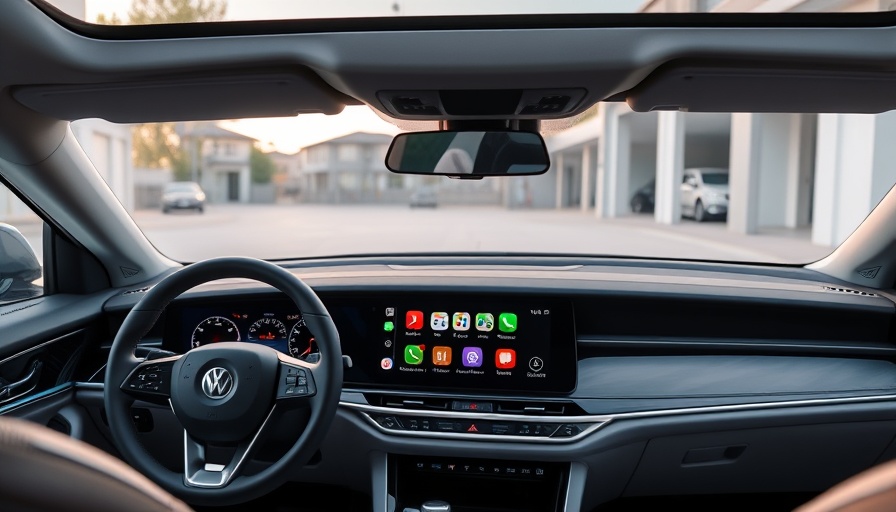
The Future of In-Car Technology: MKBHD's Insights on CarPlay Ultra
As technology rapidly evolves, the way families interact with their vehicles also changes. Recently, tech influencer MKBHD, renowned for his engaging approach to tech reviews, focused his attention on CarPlay Ultra, Apple’s next-generation in-car entertainment system. In his latest video on the aptly named Auto Focus channel, he dives deep into what this innovative system brings to the daily lives of parents on the go.
Why CarPlay Ultra Matters for Families
For many families, especially those with school-aged children, the time spent in a vehicle can be substantial. CarPlay Ultra aims to make this experience engaging and productive. This new technology promises more than just the ability to make phone calls or listen to music; it introduces a level of customization that could transform the car into a mini entertainment hub.
MKBHD's detailed review of CarPlay Ultra highlights its limited availability, currently only in select Aston Martin vehicles. However, the features available – such as enhanced app widget support, dynamic icon customization, and even video playback capabilities (if allowed by manufacturers) – make it a significant step forward for families.
The Evolution of CarPlay: What's New?
As MKBHD pointed out, the upcoming iOS 26 update will unlock powerful features for standard CarPlay users, broadening accessibility. One of the most exciting aspects is the integration of app widgets that allow parents to choose content tailored to their family’s needs, whether it’s navigation, entertainment, or communication tools that reach their kids.
These enhancements aim to create a safer driving experience, allowing drivers to access necessary functions without being distracted by multiple apps.
Driving Safety with CarPlay: A Family Perspective
For parents, safety is paramount. The evolution of CarPlay, especially with MKBHD's insights, underscores a critical aspect of driving kids - keeping attention on the road.
Enhanced features like voice recognition and streamlined dashboard options could play a crucial role in reducing distractions while allowing parents to remain connected. Family road trips or daily school runs become far less stressful when convenient tools are at your fingertips.
The Unique Appeal of MKBHD's Review
MKBHD’s ability to explain complex technologies in a digestible format resonates well with audiences. He assures parents that as technologies like CarPlay Ultra become more mainstream, they will play an integral role in shaping driving habits. His informative style is engaging and establishes a trust bridge for viewers trying to keep pace with evolving automotive tech.
By breaking down how the system works and discussing practical implications, MKBHD inspires confidence among parents looking to integrate more technology into their families' lives without compromising on safety.
Parental Benefits of Advanced CarPlay Features
The specific enhancements that CarPlay Ultra could offer can play a pivotal role in family outings or day-to-day driving. Take video playback support, for instance: while it’s currently limited, the prospect of using it (with safety in mind) could open doors for family movie nights on long trips or keeping kids engaged during commutes.
Moreover, the ability to customize app icons means that parents can prioritize applications that are essential for family logistics—like school schedules, communication apps, or entertainment preferences—right on their car screen.
Moving Ahead: Future Predictions and Insights
As the automotive industry continues to embrace technology, the future of family-focused features is bright. A move towards electric vehicles that will eventually support advanced versions of CarPlay is likely. MKBHD hints at possibilities where more manufacturers adopt this integration, and we can anticipate a proliferation of family-friendly features in newer car models.
This transition may also prompt traditional automotive companies to adapt, innovate, and enhance their technology stack in an effort to attract tech-savvy consumers making technology choices for their families.
Final Thoughts: What Parents Should Consider
As parents evaluate new vehicles or technology upgrades, MKBHD’s insights offer valuable guidance. CarPlay Ultra could lead to safer driving experiences while ensuring families remain connected and entertained on the road. Although still in its early adoption phase, the reviews from tech experts like MKBHD underscore the importance of keeping abreast of these advancements.
Keeping your family’s needs in mind while navigating this emerging landscape is vital. Engaging with engaging tech solutions can not only benefit convenience but also enhance safety and enjoyment within the family dynamic.
Want to stay updated on the future of in-car tech and safety features? Follow MKBHD for insightful reviews and practical advice that can help families like yours navigate the tech ecosystem with confidence.
 Add Row
Add Row  Add
Add 




Write A Comment